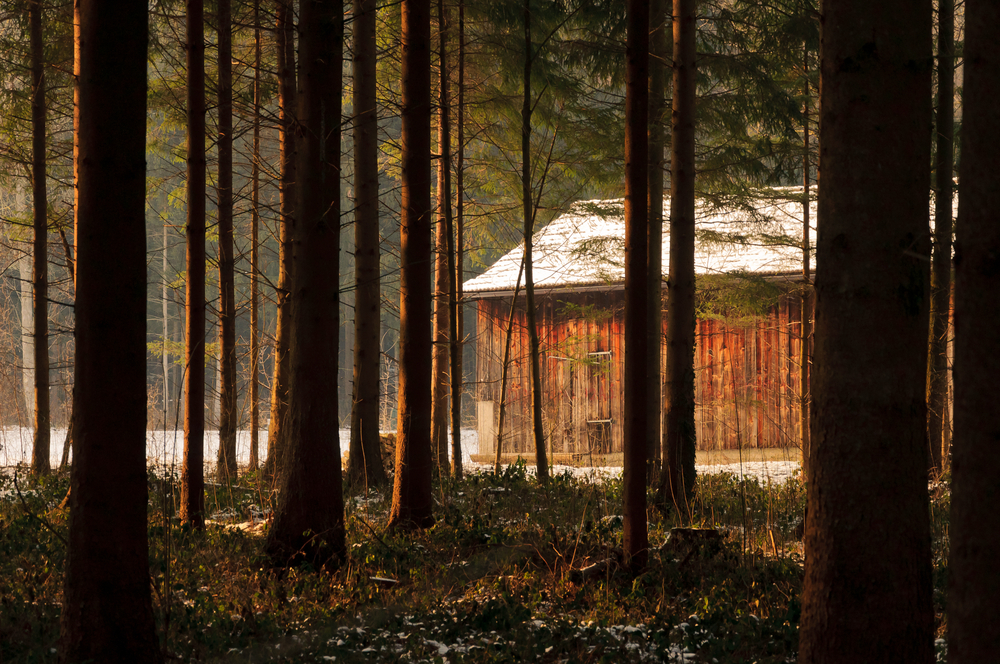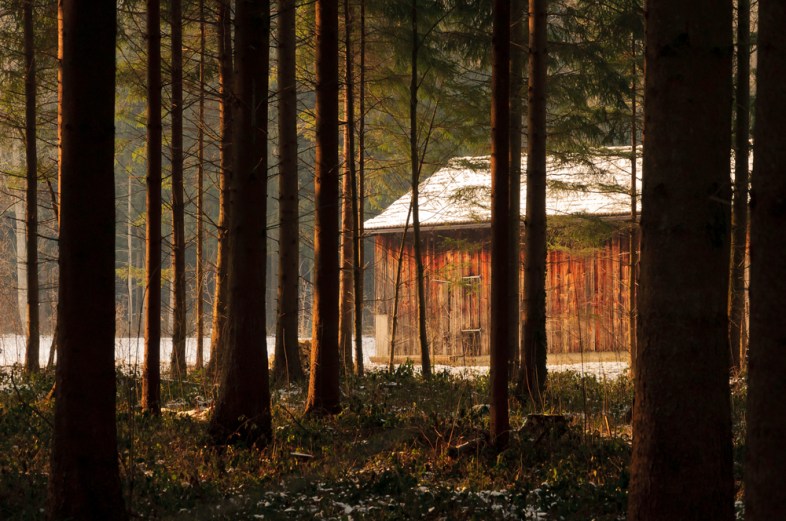
15 Things I Learned From Ditching NYC To Build A Cabin In The Woods
In the hope of inspiring a few more restless city dwellers to briefly trade a laptop for a hammer and, above all, to get outdoors, here’s a snapshot of what we learned in the woods.
By Aaron Flack

Last month, three friends and I ditched our cramped apartments in New York City, Chicago, and Raleigh to meet in a tiny town forty minutes outside of Portland, Oregon. The goal: fulfilling our dream of building a cabin in the woods.
For six days, we worked to turn a small clearing situated in a stand of stately Douglas Firs into a place of our own. Our fearless leader, a builder by trade, had the right experience to guide the project. But the rest of us were total novices.
I returned to Manhattan convinced that there is no better way to spend a week with close friends . A cabin build will beat a week in Cancun every time.
Why would a group of twenty-somethings burn a week’s worth of precious vacation days and travel thousands of miles simply to wake up with the sun, lug heavy pieces of wood through rain and mud, and essentially build a fort? It might sound nuts, but we wanted to use our hands for something other than tapping away at a keyboard or smartphone; to be directly responsible for building a place that we can enjoy together in the coming years; to use vacation for creation rather than escape; and, above all, to learn something new.
In the hope of inspiring a few more restless city dwellers to briefly trade a laptop for a hammer and, above all, to get outdoors, here’s a snapshot of what we learned in the woods.
1. Our bodies are meant not just to be used, but to be tired out—and they’re better off when we oblige them.
A day spent carrying wood, walking around a work site, and swinging a hammer is exhausting (especially if your point of reference is cubicle life), and we all slept so much better for it. It was refreshing to hit the sheets in true need of physical rejuvenation, and we awoke feeling more energized, too. Although a hard day’s labor isn’t feasible for the millions of us in office jobs, it’s important to remember that exercise is not just a countermeasure against a bad diet; it is also a primer for better sleep.
2. It’s a myth that city living must be at odds with an active, outdoor lifestyle.
Mega-cities such as New York and Chicago might bludgeon us into accepting that city living comes at the expense of an active, “fresh air” lifestyle. Yet the center of Portland—and its vibrant art scene, live music, great food, museums, professional sports, nightlife, and large population of young people—is less than an hour from our cabin. This project gave the four of us hope that in a city such as Portland (or Austin, Seattle, Nashville, the list goes on…), it is possible to put in long hours in an office job and still completely escape for a full weekend outdoors.
3. Even thirty miles from a mid-sized city, light pollution is a major problem.
We built the cabin in a thicket of trees located on a farm outside of Portland and lived on the farm for the week. Epic stargazing was anticipated, but night after night the sky above pulsed with reflections of urban light radiating from Portland and the constellation of smaller cities in its orbit. It is depressing that light from even a mid-sized city can kill a starry night thirty miles away.
4. A shared goal, even briefly held, can deepen long-term friendships.
Friends might hang out, go to dinner, and party. Good friends might live, work, and/or travel together. Best friends might share years’ worth of common experiences. But even the tightest relationships achieve some sort of plateau of normalcy. The cabin crew has been tight for ages, but being mutually invested in making the Six Day Cabin happen really brought us closer in a way that “life as usual” would not have. It’s hard to pin down but definitely something we all feel.
5. Creative play is not just for kids—adults can (and should) play, too!
No doubt the world would be pretty weird if “grown ups” spent the day playing tag or building castles out of wooden blocks. But it would do us all good to spend less time on what we are good at and more time letting our guard down, trying new things. Write a bad book. Paint a crappy picture. Build a shoddy cabin. It feeds the mind and soul.
6. Vacation can be more than mindless leisure or travel for its own sake.
There is a lot to be gained from an expanded definition of vacation. So many people take “vacation” to mean something like, “sit on a beach with a drink in hand” or “go to visit museums, restaurants, and monuments in a new city.” While those can be nice ways to spend free time, it was unusually energizing and memorable to spend the week investing in new skills while sleeping on a farm in a town that no travel blogger will ever write about.
7. There are at least ten ways to use a hammer.
Driving nails. Removing nails. Knocking blocks of wood into a tight space. Ripping holes in a wall. Scratching guide marks into wood and metal. Opening a can of paint. Cleaning the bottom of a boot. Hacking half-sawed wood apart. Measuring equal space between nails. Flattening a roll of metal flashing. One more week on a work site, and we probably could have learned ten more.
8. People love to follow a good project.
From start to finish, friends and family members were calling and texting us for updates. One friend drove out from Portland to bring us a hearty lunch (complete with nonalcoholic beers, lest a power tool be misused that afternoon) to check out the work site. Even the guys who sold us lumber at the local Home Depot asked to see a few pictures. Everyone wants a little adventure.
9. Behind any finished product are dozens of provisional steps no one will ever see.
You lay a carefully measured foundation only to hide it with four walls and a roof. You support a newly raised wall with a diagonal floor-to-ceiling 2×4 that gets removed when the second wall goes up. You attach an entire piece of plywood siding just to carve gaping rectangular holes for a door and window. You painstakingly unspool roll after roll of roofing felt, only to obscure it with a layer of shingles. It sucks to erase carefully executed work, yet—and this is true in so many pursuit—we must to destroy to create.
10. In building (as in anything), mistakes are inevitable and most can be fixed.
At one point or another, we made just about every mistake in the book. Buying the wrong lumber (Home Depot, it turns out, does take returns, even if the order weighs a thousand pounds). Hammering nails crookedly. Falling from a stepladder (…yeah, that was me). Butchering a saw job that needed to be straight. Improperly measuring slots for doors and windows. Dropping an entire rafter from fifteen feet in the air…and these barely scratch the surface.
After every mishap, however, our builder buddy William (the one guy in the group who very much knew what he was doing, as well as what the rest of us were supposed to be doing) devised a creative workaround, then he would share a story about a different time he’d seen the same mistake. He taught us that most mistakes have been made before, they’ll be made again, and a little creative thinking goes a long way.
11. For extended work and travel, wool clothes cannot be beat.
We packed light. One pair each of pants and shoes. A few pairs of socks. Sweatshirts and rain jackets. And a single wool T-shirt. By the end of the week, our pants and socks were crusty with dirt and grime and didn’t smell great. Yet our wool T-shirts remained soft and barely smelled. How is this possible? It turns out wool is naturally anti-microbial, wrinkle resistant, and durable (6x stronger than cotton!). So there’s no better fabric for extended work or travel outdoors.
12. A lot can be accomplished in the absence of a computer.
“But I can’t leave my phone at home…I’ll miss a week’s worth of emails, Snapchats, and updates from the ESPN app. NO!” So many of us are developing a phobia of disconnectedness, rooted in the feeling that nothing in work or life can get done without a laptop or smartphone.
On the build site we operated on Airplane Mode, occasionally snapping a picture or two but using our phones for nothing else. It was great to be reminded that Google searches and Quora feeds are no substitute for picking up a hammer, saw, or piece of wood—no substitute for doing something. A lot can be done in the absence of 4G, Wi-Fi, a search bar, and a keyboard.
13. The “a place of our own” ideal is totally achievable—and can even be pretty cheap.
We all came into this project with aspirations of creating a space where we can come to slow down, live simply, and kick back. We left having answered some fundamental questions:
Is 200 sq. ft. enough space? For three or four friends to spend the weekend, yes; we’ll spend most of our time outside and use the interior mainly to cook and sleep. Beyond that, it’d definitely be a tight squeeze.
Is a house like this livable longer term? It’s hard to say until we finish the interior. Even then, the answer is probably something like “It’s probably fine for me, but my girlfriend would hate it. And my mom wouldn’t visit.” We’re working on that…
Can we build a habitable space affordably? Between lumber (~$6,000), decorating the interior with rugs, blankets, bedding, etc. (this is in-progress, but let’s liberally say ~$1,000), and acquiring tools (ours were borrowed, but let’s add another few $K for tools), a project like this should cost ~$10,000 excluding land (we borrowed that, too). That’s not cheap; but if you split the cost among four or five friends and can get a mortgage on a cheap parcel of land, it’s definitely doable for a group of young people who have worked full-time for a few years (especially if everyone forgoes the annual trip to Vegas or Miami…stop wasting all that coin!)
14. Wood—even thick, heavy pieces—is unbelievably flexible.
Walk down the aisles of Home Depot, and the multi-story piles of lumber look like they’re made up of perfectly horizontal slices of wood. But load up a trundle with twenty 2x4s and you’ll be lucky to have a single one that looks dead straight upon closer examination. At first we were miffed: “How can you build a structure with bent wood?” But throughout the week we learned just how flexible wood can be when manipulated with care. With a nail gun to anchor it and a hammer to make adjustments, a twelve-foot 2×4 can safely bend an inch or two on each end. So if you make a cut half an inch too short or too long, it’s not the end of the world.
Given the way trees sway in a storm and schoolchildren bend wood pencils, perhaps this should come as no surprise, but we thought it was cool.
15. There will always be ways to make your cabin (or anything else) better, but sometimes enough is enough.
Had we spent a month building the cabin rather than a week, inevitably there would still be months or years worth of potential improvements to be made. Painting, sanding, insulating, decorating, shelving, bedding, seating, heating, plumbing…the list goes on. No doubt we’ll continue to improve the cabin over time, but with four walls, a roof, and a place to sleep, it has already exceeded our wildest expectations.
Sometimes enough is enough. We should enjoy what we have. ![]()











